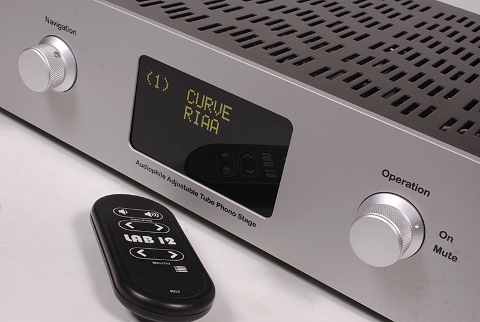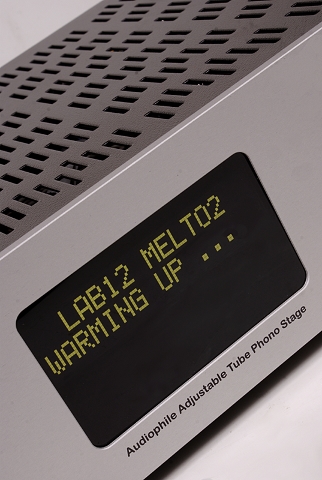about Audio, High Fidelity
& Home Entertainment technologies
pid: 607-2025/10/01 (v1.2)
Privacy Policy

During our listening sessions, melto2 replaced the reference phono preamplifier (Rotel RHQ-10 "Michi") and was driven, for the most part, from a Linn Sondek LP12/Ittok/Karma system. Its input was configured for MC, 100 Ohm load, High Gain operation and its connection to the next stage (the line preamplifier) was through the single-ended (RCA) output pair. The rest of the reference system was the standard we use in almost any review published here, including the Melos Plus Series Line preamplifier, a Parasound HCA3500 power amp, and a pair of ATC SCM50PSL loudspeakers.
The setup procedure for the melto2 did not pose any difficulties. The user should determine the standard settings that each phono cartridge normally needs, that is, the type of the generator (MM/MC), and the input load. This is easily accomplished through melto2's menu which is straightforward to navigate. In terms of usability, the most interesting feature is, of course, the ability to change parameters from the remote in real time. This means that one can instantly listen to the effect of any adjustment and decide what is best suited to its preferences. In addition to the remote (which is quite enjoyable to use) and the display (fully legible from mid-distance), the fact that the switching process does not generate any noise through the loudspeakers and the reed relays used add no mechanical noises, fully justifies LAB12's choices on this respect.
The predominant impression after melto2 introduction to the reference system was the absence of noise. Indeed, the device is extremely silent and it seems to be able to highlight all the small details the cartridge extracts from the disc. At the same time, listening is highly enjoyable, relaxed and with a sense of precision, suggesting that LAB12's design approach does not include any overdose of "personality" that would appreciably remove the feeling of neutrality from the final result.
Towards the lower part of the audio spectrum, melto2 seemed to offer good bass extension, with fast percussion attack-times, pleasantly emphasizing the rhythm section and giving a foot-tapping sense of flow, speed, and presence. A good disc, tracked by a good turntable set-up, will fill the room in an impressive way and will unfold all the details, luring the listener into the rhythm and allowing him to be isolated from his environment and following the music.
The positive presence of the preamplifier in the bass region goes hand-to-hand with a similar performance in the mids. Here, melto2 sounded notably friendly and ear-pleasing, without ever becoming euphonic or hide any details. Surely, LAB12 has made some voicing choices, here, and for this reason, the system appears to let off the hook some quite harsh or overly bright mixes and make some highly compressed tracks more compelling. Nevertheless, the end result is well-balanced without a standing out, sui-generis character tending towards the listener. Instead, what is offered is a soundstage with a very good feeling of air, excellent audio object description, a lively, gleaming, presence and a very positive feeling of closeness. Although the system, with the melto2 in it, never reached close to an in-your-face “over-analytic” character, an attribute frequently encountered in digital sources (and not necessarily negative, mind you), we had the feeling that we were close to what was happening and that there was serious capacity of focus, flawless description of free space, and a sense of depth and discipline in the stereo image. Voices were well set out, expressive, with good detail and timbre presentation and, given a good recording, exemplary life-sized. The final result could be described as transparent, allowing the source to pass through what's on the record and was one of the best we've had the opportunity to listen to lately.
Towards the high-frequency part of the audio spectrum, the overall sense of balance was maintained and the system appeared to keep its rich, open-sounded character with very good sense of sustain and release times, while a little bit slow in attack, relative to our reference, a feature that may convincingly explain why melto2 sounds more relaxed and tolerant to bright and/or harsh mixes. Harmonic content was well reproduced, with a very good sense of balance, and the final result never sounded dry. Rich in high-frequency components content is a good opportunity to notice the preamplifier's capacity to manage the small details. Its very low noise (already acknowledged as a strong impression during the first listening sessions) creates a fully dark background, on which small elements of the recording are successfully projected, a behavior that brings up the sense that the system offers excellent microdynamics and, given a good power amp/loudspeaker combination, can effortlessly follow the macrodynamics of any track, to the limits imposed by the analog media and the source itself.
Conclusion
It is clear to me that, in the case of melto2, we are dealing with a well-balanced design, one which ideally blends the advantages of high quality, tube-based, circuit, with good connectivity and great attention to the details. These, result in a skillfully voiced device, offering a natural but both ear- and program-friendly listening experience, a pair of attributes that sets the basis of a great audiophile phono preamplifier. Moreover, melto2 is highly adjustable and very easy to use, suitable for systems with a good analog front-end and users with a serious record collection, at a reasonable price. Highly recommended!”
Listening Sessions Recording
The following recordings were made with a DV-RA1000 Tascam master recorder (using 24bit/192kHz sample rate) and you can download them to have an impression of what the device under review sounded like. It is obvious that any recording of this kind could not be absolutely transparent but, according to our experience, the majority of sound attributes we listen to, during the actual listening sessions, are preserved. No need to say that you should use these samples cautiously and for informative purposes only. Do not rely on them exclusively to make any buying decisions. The file format is .flac, so expect that the zipped files will be quite large (even if the clips are about a minute or less long. You could use an ABX listening tool like the ABX plug-in for foobar2000 if you want to make some more elaborate experiments. Contact us if you have any questions.
| Listening Sessions Recording TOC | |
|---|---|
| Track #01 | Linn Sondek LP12/Ittok/Karma | LAB12 melto2 (MC, 100 Ohm, High Gain) |
| Track #02 | Reference: Linn Sondek LP12/Ittok/Karma | Rotel RHQ-10 (MC, 100Ω) |
Previous | Next | More Reviews



